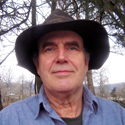Trail Talk – May 2019
Spring projects in Forest Park are moving ahead nicely. By now, patrons have enjoyed the new Wildlife Viewing Shelter at the historic Jacksonville Reservoir, the new vault toilets at parking area P1A (dam quarry), a new, improved Mountain Biking Information Kiosk, and the Rattlesnake Gulch Tr that takes hikers from Siskiyou Tr to Siskiyou View Loop. Wildflowers are putting on a spectacular show after the welcome winter snows and rains.
The new map has been distributed widely, both as paper and digitally and visitors are enjoying the more remote trails as challenging hikes. Two issues ago, I spoke to the responsibility of trail users to help safeguard the trails. Maintaining travel in the center of the trail, not cutting corners, and resisting the urge to create un-authorized pathways are important to protect trail integrity and keep the trails open for use.
The new Forest Park map clearly shows, through the use of color, just what one can expect on different trails. A ‘brown’ trail is multiple use and is open to both foot travel and mountain bikes. In steep areas one may encounter switchback corners or ’S’ turns to lessen grade. These are also necessary to slow traffic on steep descents and to prevent trail erosion. The grade is maintained to avoid any steep ‘fall lines’ that lead to erosion, and may have numerous water bars to shed run-off. Bike riders may have to dismount on these corners, particularly when traveling uphill.
Trails designated for bicycle use are red on the map, and hikers should avoid these routes. These trails are designed with minimal ’S’ turns, which, if necessary, should be gradual and sweeping. It’s critical that riders avoid the temptation to cut these turns because that leads to eroded hillsides and potentially closed trails. Although hikers should not be encountered on these trails, diligence while riding is always important.
Hiker-only trails are green in color on the new map. They are also posted as ‘No Bike’ trails. These trails are generally on steep hillsides and along sensitive creekside areas. Visitors can expect steps and sharp switchbacks. These trails will often have damp or wet tread, and it’s important to hike in the center of the trail. Amphibians and reptiles are most often seen in the areas these trails traverse, and sensitive wildflower areas are common. One will often encounter ‘step-over’ logs that are left in place to discourage un-authorized bicycle traffic. The width of the tread is minimal to have as little impact as possible, inviting folks to travel quietly and mindfully of the special places they are visiting.
More benches have been added throughout the park, especially on some of the higher elevation hiking trails where distant horizons can be enjoyed. Knobcone Pine Tr boasts two spectacular viewing areas, where one’s gaze sweeps from Mt Ashland along the Siskiyou Crest to Red Buttes. Yes, that is California! And from the new loop trail on Arrowhead Pass, the view up the Applegate Valley is quite breath-taking. It’s time to be outdoors.
 Trail Talk is a monthly column by Clayton Gillette about hiking the Jacksonville Woodlands trail system. For more information, please visit the Jacksonville Woodlands Association website at
Trail Talk is a monthly column by Clayton Gillette about hiking the Jacksonville Woodlands trail system. For more information, please visit the Jacksonville Woodlands Association website at